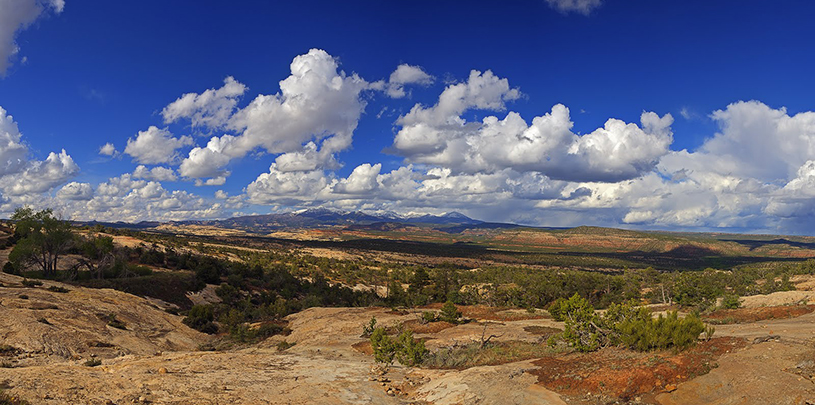
In a ceremony at the Utah State Capitol today, conservation groups, Rep. Rob Bishop, R-Utah, and officials from Daggett County and the state of Utah announced a landmark agreement on public lands protection. The plan would result in new wilderness areas and river and wildlife protections–including an internationally renowned tailwater trout fishery on the Green River and increased wilderness protection for the High Uintas, treasured by hunters, hikers, and families–as part of a process initiated by Rep. Bishop.
“Wilderness lets us visit a place that is as it was when my family arrived here 7 generations ago. A place that 7 generations hence can experience in the same way our ancestors did. In this way wilderness connects us to our family tree – both our forebears and those yet to come,” said Tim Peterson, Utah Wildlands Program Director for Grand Canyon Trust. “Wilderness is place to shape and strengthen our children’s character in wild nature as my own character was molded as a boy with my family in the High Uintas – a place we’re celebrating today.”
Home to Flaming Gorge National Recreation Area and reservoir as well as significant National Forest system lands in the Uinta Mountains, Daggett County also includes Browns Park, an isolated and beautiful valley that is the gateway to the Canyon of Lodore and Dinosaur National Monument. It’s steeped in the history of the old west – Butch Cassidy and the Wild Bunch, the Hole in the Wall gang and others used Browns Park for refuge after robberies in Green River and Rock Springs, Wyoming and the nearby rail line. The agreement marked a major breakthrough in the Eastern Utah Public Lands Initiative (PLI), conceived by Bishop to build consensus among stakeholders in eastern Utah to designate lands for both conservation and development.
The proposal designates 82,408 acres of federal land as wilderness areas, classifies an additional 31,083 acres of federal land for a separate conservation designation to preserve wildlife and habitat and designates fourteen miles of the Green River for inclusion in the National Wild and Scenic River System. The High Uintas Wilderness – Utah’s highest and largest at 456,705 acres – would gain 50,000 acres of wilderness, bringing the total to over half a million acres. The proposal would also set up a mechanism for trading scattered state trust land inholdings in conservation areas for development-appropriate federal land elsewhere.
The deal calls for the trade of some Forest Service lands near the junction of the county’s two major highways – US 191 and UT 44 –to Utah’s School and Institutional Trust Lands Administration (SITLA), which works to generate revenue from the state’s public lands to benefit the public schools–for a possible year-round ski/destination resort. In exchange, SITLA lands adjacent to the current Forest Service boundary will become National Forest lands. The community of Dutch John will expand its footprint by roughly 800 acres to acquire a possible landfill site and rifle range. In exchange for trading out of newly protected areas, SITLA will also acquire a deep cavern natural gas storage facility at Clay Basin, potentially returning significant revenues to the county.
An active and solution-oriented coalition, including the Grand Canyon Trust, Southern Utah Wilderness Alliance, The Wilderness Society, Natural Resources Defense Council, and the Sierra Club and other conservation organizations like Trout Unlimited worked with officials to finalize a Daggett County proposal. This agreement is intended to provide a framework for legislation to be introduced by Rep. Bishop.
“It’s rare in today’s highly politicized environment to be able to meet in the middle on issues, especially issues of public lands protection,” remarked Mark Clemens, Chapter manager for the Utah Sierra Club. “The end result though is a win for everyone.”
Daggett was among the last counties to join the PLI, but a willingness to give and take on wilderness and land exchange helped establish common ground.
“We believe this good news can serve as a blueprint in going forward to resolve the range of complex conservation and economic issues associated with other wild places in Utah,” said Bobby McEnaney, Senior Lands Advocate for the Natural Resources Defense Council.
“This proposal is good for the land and good for the people that live there,” said Paul Spitler, Director of Wilderness Campaigns for The Wilderness Society.
All in all, the agreement is a victory for wildland conservation in some of northeast Utah’s most remote and breathtaking landscapes. This is the way everybody always hopes we will work together. Daggett is a county with about 10,000 acres of Wilderness Study Areas and has agreed to more than 110,000 acres of permanent protection. We’re optimistic that what we’ve achieved in Daggett can serve as a model as we move forward in this process with other counties.
80% of Arizona voters support Baaj Nwaavjo I'tah Kukveni National Monument, according to a new poll.
Read MoreUtah voters strongly support national monuments in general, and Bears Ears and Grand Staircase-Escalante in particular, a new poll shows.
Read MoreDon't let a little snow keep you from visiting the Grand Canyon. Here's everything you need to know for a winter trip to the big ditch.
Read More